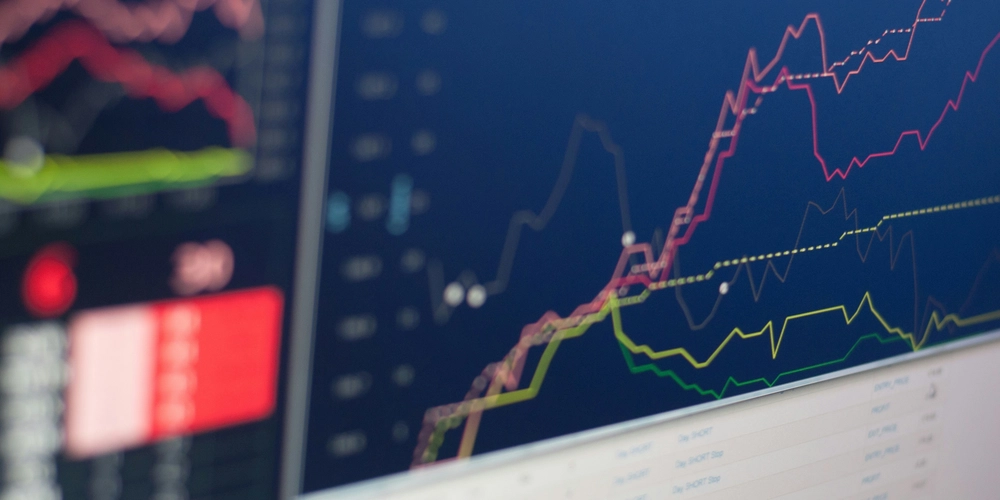The Relationship Between GDP and Stock Market Performance
The relationship between Gross Domestic Product (GDP) and stock market performance is a subject of considerable interest to economists, investors, and policy makers alike. GDP measures the total value of goods and services produced by a country, and it serves as an indicator of the health and growth of an economy. The stock market, on the other hand, reflects the collective value of publicly traded companies and serves as a platform for buying and selling shares. Both metrics are often used to gauge economic conditions, yet their relationship is more complex than a simple correlation. While there is a connection between GDP growth and stock market performance, this relationship is influenced by various factors, including investor sentiment, economic policies, and external events. In some cases, an increase in GDP might lead to higher stock market returns, but there are also situations where the stock market might not follow the same trajectory as GDP growth. The dynamics between these two economic indicators are shaped by a number of elements that can create divergence between what is happening in the broader economy and in the financial markets. How GDP Growth Affects Stock Market Performance In general, periods of strong economic growth, as indicated by an increasing GDP, are often associated with rising stock market performance. As GDP grows, businesses tend to experience higher demand for their goods and services. This, in turn, can lead to increased revenues, higher profits, and a positive outlook on corporate performance. Investors, seeing these favorable conditions, may respond by purchasing stocks, which can push prices up and increase the value of the stock market. In addition to boosting corporate earnings, GDP growth is typically accompanied by rising employment rates, higher wages, and increased consumer spending. These factors create a cycle of growth that benefits both businesses and the broader economy. Stock markets, reflecting investor expectations of sustained economic activity, often respond positively when there are signs of strong or accelerating economic growth. As corporate profits rise, stock prices often follow suit, contributing to a positive feedback loop between the economy and financial markets. However, the stock market can sometimes reflect investor optimism or pessimism about the future, regardless of current GDP data. While economic growth may suggest positive conditions, stock prices are often influenced by expectations about future performance, both of individual companies and of the economy as a whole. These expectations can lead to stock market movements that don’t always align with current economic conditions. The Stock Market as a Leading Indicator While GDP measures past economic activity, the stock market is often seen as a leading indicator, meaning that stock prices tend to reflect investor expectations about future economic conditions. Investors generally buy and sell stocks based on what they anticipate will happen in the economy, rather than what is currently occurring. If investors believe that GDP will grow in the future, stock prices may increase, even before the official data confirms this growth. This forward-looking nature of the stock market can create a situation where the stock market moves in anticipation of future GDP growth or contraction. If investors expect economic growth to continue, they may begin purchasing stocks in anticipation of higher earnings, leading to an increase in stock market value. Similarly, if there are concerns about an economic slowdown or a recession, stock prices may fall as investors adjust their portfolios in response to anticipated declines in economic activity. The market’s role as a leading indicator of economic conditions can sometimes result in stock market movements that diverge from GDP data. Stock markets can reflect a combination of current conditions, future expectations, and investor sentiment, which might lead to a disconnect between stock market performance and the actual state of the economy. Interest Rates, Inflation, and the Stock Market Interest rates and inflation are key factors that influence both GDP growth and stock market performance. Central banks, such as the Federal Reserve in the United States, use interest rates as a tool to manage economic conditions. When GDP is growing too quickly and inflation begins to rise, central banks may raise interest rates to cool down the economy. Higher interest rates make borrowing more expensive, which can reduce consumer spending and business investment, potentially slowing down economic growth. The effect of interest rate changes on the stock market can be significant. Higher interest rates typically make bonds and other fixed-income investments more attractive, leading investors to move money out of the stock market and into these safer assets. As a result, rising interest rates can sometimes lead to lower stock prices,

The relationship between Gross Domestic Product (GDP) and stock market performance is a subject of considerable interest to economists, investors, and policy makers alike. GDP measures the total value of goods and services produced by a country, and it serves as an indicator of the health and growth of an economy. The stock market, on the other hand, reflects the collective value of publicly traded companies and serves as a platform for buying and selling shares. Both metrics are often used to gauge economic conditions, yet their relationship is more complex than a simple correlation.
While there is a connection between GDP growth and stock market performance, this relationship is influenced by various factors, including investor sentiment, economic policies, and external events. In some cases, an increase in GDP might lead to higher stock market returns, but there are also situations where the stock market might not follow the same trajectory as GDP growth. The dynamics between these two economic indicators are shaped by a number of elements that can create divergence between what is happening in the broader economy and in the financial markets.
How GDP Growth Affects Stock Market Performance
In general, periods of strong economic growth, as indicated by an increasing GDP, are often associated with rising stock market performance. As GDP grows, businesses tend to experience higher demand for their goods and services. This, in turn, can lead to increased revenues, higher profits, and a positive outlook on corporate performance. Investors, seeing these favorable conditions, may respond by purchasing stocks, which can push prices up and increase the value of the stock market.
In addition to boosting corporate earnings, GDP growth is typically accompanied by rising employment rates, higher wages, and increased consumer spending. These factors create a cycle of growth that benefits both businesses and the broader economy. Stock markets, reflecting investor expectations of sustained economic activity, often respond positively when there are signs of strong or accelerating economic growth. As corporate profits rise, stock prices often follow suit, contributing to a positive feedback loop between the economy and financial markets.
However, the stock market can sometimes reflect investor optimism or pessimism about the future, regardless of current GDP data. While economic growth may suggest positive conditions, stock prices are often influenced by expectations about future performance, both of individual companies and of the economy as a whole. These expectations can lead to stock market movements that don’t always align with current economic conditions.
The Stock Market as a Leading Indicator
While GDP measures past economic activity, the stock market is often seen as a leading indicator, meaning that stock prices tend to reflect investor expectations about future economic conditions. Investors generally buy and sell stocks based on what they anticipate will happen in the economy, rather than what is currently occurring. If investors believe that GDP will grow in the future, stock prices may increase, even before the official data confirms this growth.
This forward-looking nature of the stock market can create a situation where the stock market moves in anticipation of future GDP growth or contraction. If investors expect economic growth to continue, they may begin purchasing stocks in anticipation of higher earnings, leading to an increase in stock market value. Similarly, if there are concerns about an economic slowdown or a recession, stock prices may fall as investors adjust their portfolios in response to anticipated declines in economic activity.
The market’s role as a leading indicator of economic conditions can sometimes result in stock market movements that diverge from GDP data. Stock markets can reflect a combination of current conditions, future expectations, and investor sentiment, which might lead to a disconnect between stock market performance and the actual state of the economy.
Interest Rates, Inflation, and the Stock Market
Interest rates and inflation are key factors that influence both GDP growth and stock market performance. Central banks, such as the Federal Reserve in the United States, use interest rates as a tool to manage economic conditions. When GDP is growing too quickly and inflation begins to rise, central banks may raise interest rates to cool down the economy. Higher interest rates make borrowing more expensive, which can reduce consumer spending and business investment, potentially slowing down economic growth.
The effect of interest rate changes on the stock market can be significant. Higher interest rates typically make bonds and other fixed-income investments more attractive, leading investors to move money out of the stock market and into these safer assets. As a result, rising interest rates can sometimes lead to lower stock prices, even if GDP growth is still positive. Conversely, when central banks lower interest rates, the stock market may respond positively as cheaper borrowing costs can stimulate spending and investment.
Inflation also plays a role in the relationship between GDP and the stock market. If GDP growth leads to inflationary pressures, the central bank may raise interest rates to prevent the economy from overheating. Inflation erodes the purchasing power of consumers and can increase the cost of doing business, both of which can negatively impact corporate profits. As a result, stock prices may decline during periods of high inflation, even if GDP growth remains steady.
The Role of Investor Sentiment and External Factors
Investor sentiment can significantly impact the relationship between GDP and stock market performance. While GDP provides an objective measure of economic activity, stock prices are heavily influenced by how investors feel about the future. In times of uncertainty or crisis, such as during geopolitical tensions or financial market disruptions, stock prices may decline even if GDP growth remains positive. Investor fear or optimism can push stock prices in directions that don’t always reflect underlying economic fundamentals.
External factors such as political events, natural disasters, and global economic conditions can also affect the stock market, sometimes independently of GDP growth. For example, changes in government policy, such as trade tariffs or tax reforms, can influence corporate earnings and investor confidence, causing fluctuations in stock prices. Similarly, changes in oil prices or global supply chain disruptions can impact the stock market, even if domestic GDP growth remains steady.
Because of the myriad factors influencing stock market performance, the stock market is often more volatile than GDP data. While GDP growth provides a broad view of economic conditions, stock market movements are often driven by a combination of domestic and global factors, investor behavior, and expectations about the future.
Recessions, Stock Market Declines, and Recovery
The relationship between GDP and stock market performance is especially apparent during periods of economic recession. During a recession, GDP contracts, and businesses experience slower growth, reduced earnings, and higher unemployment. As a result, stock markets often experience declines during recessions, as investors adjust their expectations for future economic performance. However, stock markets may begin to recover before GDP growth resumes, as investors anticipate an eventual economic recovery.
Stock markets are often quicker to react to changes in economic conditions than GDP, which is reported on a quarterly basis. As a result, stock prices may begin to rebound before GDP figures show signs of growth. This phenomenon reflects the stock market’s forward-looking nature, as investors buy stocks in anticipation of improved economic conditions, even when current GDP data indicates a contraction.
The timing of stock market recoveries following recessions can vary depending on a range of factors, including government intervention, changes in consumer behavior, and shifts in business investment. Stock markets may also recover at different rates across sectors, with industries that are more sensitive to economic cycles—such as consumer discretionary or financial services—experiencing more pronounced fluctuations than others.
The Complex Relationship Between GDP and Stock Market Performance
In summary, while GDP growth and stock market performance are often linked, the relationship is shaped by numerous factors. Strong GDP growth is typically a positive signal for the stock market, but it is not the sole determinant of stock prices. The stock market reflects a range of expectations, investor sentiment, and external conditions that can cause stock prices to move independently of current economic conditions. Moreover, interest rates, inflation, and geopolitical events play significant roles in shaping the dynamics between GDP and stock market performance.
Understanding the interplay between GDP and the stock market requires a nuanced approach, recognizing that while they are both key economic indicators, their relationship is influenced by a variety of factors that can create divergence in short-term trends. Ultimately, the stock market is a complex system, and while it may often reflect the broader economic conditions indicated by GDP, it also responds to a wide array of other influences that can drive short-term fluctuations.









































































































































































![[The AI Show Episode 146]: Rise of “AI-First” Companies, AI Job Disruption, GPT-4o Update Gets Rolled Back, How Big Consulting Firms Use AI, and Meta AI App](https://www.marketingaiinstitute.com/hubfs/ep%20146%20cover.png)

























































































































![[DEALS] The Premium Python Programming PCEP Certification Prep Bundle (67% off) & Other Deals Up To 98% Off – Offers End Soon!](https://www.javacodegeeks.com/wp-content/uploads/2012/12/jcg-logo.jpg)















































































































































_Aleksey_Funtap_Alamy.jpg?width=1280&auto=webp&quality=80&disable=upscale#)
_Sergey_Tarasov_Alamy.jpg?width=1280&auto=webp&quality=80&disable=upscale#)













































































































![Apple Foldable iPhone to Feature New Display Tech, 19% Thinner Panel [Rumor]](https://www.iclarified.com/images/news/97271/97271/97271-640.jpg)
![Apple Developing New Chips for Smart Glasses, Macs, AI Servers [Report]](https://www.iclarified.com/images/news/97269/97269/97269-640.jpg)
![Apple Shares New Mother's Day Ad: 'A Gift for Mom' [Video]](https://www.iclarified.com/images/news/97267/97267/97267-640.jpg)
![Apple Shares Official Trailer for 'Stick' Starring Owen Wilson [Video]](https://www.iclarified.com/images/news/97264/97264/97264-640.jpg)



































































































